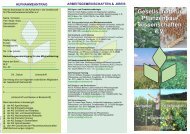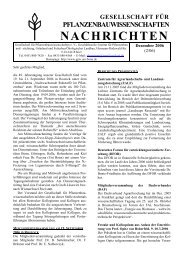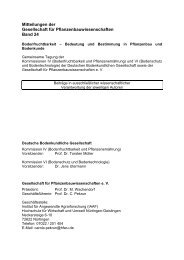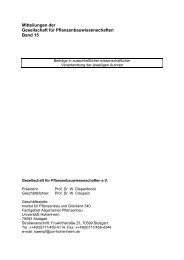Mitteilungen der Gesellschaft für Pflanzenbauwissenschaften Band 23
Mitteilungen der Gesellschaft für Pflanzenbauwissenschaften Band 23
Mitteilungen der Gesellschaft für Pflanzenbauwissenschaften Band 23
Erfolgreiche ePaper selbst erstellen
Machen Sie aus Ihren PDF Publikationen ein blätterbares Flipbook mit unserer einzigartigen Google optimierten e-Paper Software.
Mitt. Ges. Pflanzenbauwiss. <strong>23</strong>: 222 (2011)<br />
Comparison of active and passive spectral sensors<br />
in discriminating biomass parameters and nitrogen status<br />
in wheat cultivars<br />
Klaus Erdle, Bodo Mistele and Urs Schmidhalter<br />
Lehrstuhl <strong>für</strong> Pflanzenernährung, Technische Universität München, Freising. E-Mail: erdle@wzw.tum.de<br />
Introduction<br />
Several sensor systems are available for ground-based remote sensing in crop<br />
management. Vegetation indices of multiple active and passive sensors have seldom<br />
been compared in determining plant health. This work describes a study comparing<br />
active and passive sensing systems in terms of their ability to recognize agronomic<br />
parameters.<br />
Material and Methods<br />
One bi-directional passive radiometer (BDR) and three active sensors, including the<br />
Crop Circle, GreenSeeker, and an active flash sensor (AFS), were tested for their<br />
ability to assess six destructively determined crop parameters. Over two years, seven<br />
wheat (Triticum aestivum L.) cultivars were grown with nitrogen supplies varying from<br />
0 to 220 kg ha -1 . At three developmental stages, the crop reflectance was recorded<br />
and sensor-specific indices were calculated and related to N levels and the crop<br />
parameters, fresh weight, dry weight, dry matter content, as percent of dry weight to<br />
fresh weight, N content, aboveground N uptake, and the nitrogen nutrition index.<br />
Results and Discussion<br />
The majority of the tested indices, based on different combinations of wavelengths in<br />
the visible and near infrared spectral ranges, showed high r 2 -values when correlated<br />
with the crop parameters. However, the accuracy of discriminating the influence of<br />
varying N levels on various crop parameters differed between sensors and showed<br />
an interaction with growing seasons and developmental stage. Visible- and red lightbased<br />
indices, such as the NDVI, simple ratio (R780/R670), and related indices tended<br />
to saturate with increasing crop stand density due to a decreased sensitivity of the<br />
spectral signal. Among the destructively assessed biomass parameters, the best<br />
relationships were found for N-related parameters, with r 2 -values of up to 0.96. The<br />
near infrared-based index R760/R730 was the most powerful and temporarily stable<br />
index indicating the N status of wheat. This index was delivered by the BDR, Crop<br />
Circle, and AFS. Active spectral remote sensing is more flexible in terms of timeliness<br />
and illumination conditions, but to date, it is bound to a limited number of indices. At<br />
present, the broad spectral information from bi-directional passive sensors offers<br />
enhanced options for the future development of crop- or cultivar-specific algorithms.







